MUTAGENIC INDUCTION OF AGRONOMICAL AND YIELD CONTRIBUTING TRAITS IN SOYBEAN (GLYCINE MAX (L.) MERRILL) WITH GAMMA IRRADIATION
Bạn đang xem bản rút gọn của tài liệu. Xem và tải ngay bản đầy đủ của tài liệu tại đây (932.22 KB, 10 trang )
J. Sci. & Devel., Vol. 10, No. 4: 576-585
Tạp chí Khoa học và Phát triển 2012 Tập 10, số 4: 576-585
www.hua.edu.vn
MUTAGENIC INDUCTION OF AGRONOMICAL AND YIELD CONTRIBUTING TRAITS IN
SOYBEAN (
GLYCINE MAX
(L.) MERRILL) WITH GAMMA IRRADIATION
Vũ Đình Hòa
*
, Nguyễn Văn Giang
Faculty of Biotechnology, Hanoi University of Agriculture
*
Email:
Received date: 14.05.2012 Accepted date: 21.09.2012
ABSTRACT
The effects of different doses of gamma rays (0, 15, 18, 21 kR) on mutagenic induction in soybean (Glycine max
(L.) Merill) cv ĐVN6, ĐT12 and ĐT20 were investigated. The sensitivity response of soybean to gamma radiation
was determined based on seed germination, plant survival and growth reduction in the M
1
generation. The mutation
changes were observed on the morphological and agronomic characters and yield components, including leaf color
and shape, maturity, plant height, branching habit, number of branches per plant, pods/plant, 1000 seed weight and
yield/plant in the M2, M
3
and M
4
generations. In general, the reduction of phenotypic expression in M
1
generation is
proportional with the dose of gamma irradiation. Although cultivars responded slightly different, the critical dose for
inducing mutation was established at 21 kR. In M
2
generation high proportion of chlorophyll and agro-morphological
mutations were observed, indicative of effectiveness of mutagenic treatment. With regard to quantitative traits, both
negative and positive shifts in mean values as well as increased phenotypic variation were recorded in M
2
, M
3
and M
4
generation as a result of mutagenic treatment. Moderate to high broad-sense heritabilities in the M
3
generation were
found for plant height, number of branches, number of pods per plant and seed weight, but rather low for grain yield
per plant, suggesting possibility for improvement through selection of yield components. A total of 15 M
4
-lines
possessing agronomic and yield contributing traits similar to or better than the parents were selected and they offer
good scope for improvement of soybean.
Key words: Gamma irradiation, mutagenic effects, soybean, yield traits.
Cảm ứng đột biến các tính trạng nông học và các tính trạng đóng góp vào năng suất
ở đậu tương (Glycine max (L.) Merrill) bằng tia gamma
TÓM TẮT
Thí nghiệm được tiến hành nhằm xác định ảnh hưởng của tia gamma với các liều lượng khác nhau (0, 15, 18,
21 kR) đến cảm ứng đột biến ở các giống đậu tương ĐVN6, ĐT12 và ĐT20. Độ mẫm cảm của đậu tương với tia
gamma được xác định dựa vào tỉ lệ nảy mầm, tỉ lệ sống sót và mức suy giảm sinh trưởng ở thế hệ M
1
. Những thay
đổi đột biến đuợc khảo sát trên các đặc điểm hình thái, đặc điểm nông học và các yếu tố cấu thành năng suất, gồm
màu sắc và dạng lá, thời gian sinh trưởng, chiều cao cây, mức độ phân cành, số cành, số quả/cây, khối lượng hạt và
năng suất cá thể ở các thế hệ M2, M
3
và M
4
. Nhìn chung, sự suy giảm về biểu hiện kiểu hình ở thế hệ M
1
tỉ lệ thuận
với liều lượng chiếu tia gamma. Mặc dù các giống phản ứng có khác biệt nhưng không đáng kể, liều lượng tới hạn
để cảm ứng đột biến được xác định là 21 kR. Ở thế hệ M
2
tỉ lệ đột biến diệp lục và đột biến hình thái tương đoi cao
chứng tỏ hiệu quả của xử lý đột biến.. Với các tính trạng số lượng, đã quan sát thấy sự thay đổi giá trị trung bình
theo hai hướng so với giống gốc cũng như tăng biến động kiểu hình ở các thế hệ M
2
, M
3
and M
4
. Các tính trạng
chiều cao cây, số cành, số quả/cây và khối lượng hạt có hệ số di truyền nghĩa rộng từ trung bình đến cao, nhưng hệ
số di truyền của năng suất cá thể thấp, cho thấy chọn lọc các yếu tố cấu thành năng suất có thể cải tiến năng suất.
Tổng số 15 dòng thế hệ M
4
có những đặc điểm nông học và các yếu tố cấu thành năng suất tương đương hoặc tốt
hơn các giống gốc được chọn lọc làm vật liệu cho việc cải tiến đậu tương.
Từ khóa: Ảnh hưởng đột biến, đậu tương, tia gamm
a, tính trạng năng suất.
1. INTRODUCTION
Soybean (Glycine max (L.) Merill) is an
important world oil seed crop and posses a very
high nutritional value. It contains about 20%
oil and 40% protein and ranks the first in the
world production of oilseeds. For Vietnam,
soybean is the most significant grain legume
576
Vũ Đình Hòa, Nguyễn Văn Giang
for feed, oil and soyfood products. Soybean is a
self-pollinated legume and natural crossing
rate is rather low, varying from <0.5 to about
1% (Carson and Lersten, 1987). During the last
the decades, soybean breeding has been limited
to hybridization within primary gene pool,
particularly among commercial germplasm and
selection was focused on high yielding
genotypes and high seed protein and oil. In
effect, this leads to narrow genetic base of
soybean cultivars (Singh and Hymowitz, 1999).
In Vietnam
, the area under soybean and
its production in 2010 was estimated at 197.8
thousand hectares and 297,000 MT,
respectively.. Statistical data show that
national average soybean yield in 2010 was
only 1.5 tones ha
-1
. Soybean is not a native
plant of Vietnam. Therefore, the genetic
diversity of soybean grown in Vietnam is
rather poor, with most direct introductions
from China and breeding and selection from
the introduced germplasm. The limited use of
diverse cultivars presents major constraints for
soybean improvement in general and
enhancing yield in particular through
conventional breeding methods. Hence,
alternative methods of generating variability
have gained greater importance in breeding of
crop plants including soybean and may serve
as supplements to conventional breeding
methods. In this context, mutation breeding
would supplement conventional plant breeding
as a source of generating new genetic
variability and could confer specific
improvement without significantly altering its
acceptable phenotype (Ojomo et al., 1979).
Although mutation breeding in soybean was
lagging behind other economically important
crops, more than 100 new soybean cultivars
have been developed and released for
commercial production through the use of
chemical or physical mutagens (Shu and
Manjaya, 2007). Mutagenic induction in
soybean has produced considerable genetic
variation for both qualitative and quantitative
traits (Rawling et al., 1958; Papa et al., 1961;
Santos et al., 1970; Constantin et al., 1976;
Imam, 1978; Maheshwari et al., 2003) from
which desirable and useful mutants could be
selected. The traits meliorated by mutation
include high oleic acid content (Tagaki và
Rahman, 1996), fatty acid composition
(Hammond and Fehr, 1983; Fehr et al., 1991;
Wilcox and Cavins, 1990), high protein content
(Srisombunet al., 2009), increased pod numebr
plant-1 (Tambe and Apparao, 2009), herbicide
tolerance (Sebastian và Chaleff, 1987;
Sebastian et al., 1989), plant type (Khan et al.,
2005), early maturity (Neto and Alves, 1997),
breaking linkage block (Hajika et al., 1995).
Developin
g new cultivars of crops
requires base populations that possess high
genetic variability through several means:
hybridization, mutation and genetic
transformation. This is completely true for
soybean, a strictly self-pollinated crop to
facilitate selection efforts for desirable traits,
such as yield components and tolerance to
environmental stresses.
Mutat
ion induction with ionizing
radiation, especially gamma ray, is currently
the most frequently used method to develop
mutant cultivars, where hybridization and
selection appear to be laborious and time
consuming. The present investigation
attempted to use gamma irradiation to induce
changes in agronomic and yield contributing
traits of existing cultivars, ĐN6, ĐT12 and
ĐT20 for selection towards improving yield.
2. MATERIALS AND METHODS
Seeds of three soybean cultivars ĐN6,
ĐT12 and ĐT20 were obtained from Center
for National Testing of Plant Products and
Fertilizers, Ministry of Agriculture and Rural
Development. These cultivars are of
determinate growth habit. The seeds were
treated with gamma rays at 0, 12, 15, 18 and
21 kR at Hanoi Center for Irradiation. Each
treatment consisted of 400 seeds. Both
irradiated and control (0 kR) seeds were sown
on field plots following a randomized block
design in triplicate at a spacing of 40 x 10 cm
(5 m
2
plots, 25 plants per square meter) to
raise M
1
generation during 2010 spring
577
Mutagenic induction of agronomical and yield contributing traits in soybean (Glycine max (L.) Merrill)
with gamma irradiation
578
Sev
eral abnormalities were observed in
M
1
generation following gamma radiation. The
undesirable changes resulting from
chromosomal aberrations and toxicity are
manifested as M1 damage such as lethality
and injury, and these adversely expressed in
germination, survival, seedling defects, plant
growth and chlorophyll deficiency. Although
there was slight difference among soybean
cultivars in response to gamma irradiation,
seed germination and survival of plants of all
cultivars decreased progressively with
increased dose of gamma rays (Table 1). The
decrease in germination and survival has
been attributed to the physiological
disturbance or chromosomal damage caused to
the cells of the plant by the physical mutagen.
It was observed that reduction of survival was
mainly due to malformed cotyledonary leaves
or retarded primary leaf growth leading to the
death of seedlings. These reduced germination
and survival were also reported in several
other studies with soybean (Constantin et al.,
1976; Balakrishman, 1991; Karthika and
Lakshmi, 2006; Pavadai et al., 2010), cowpea
(Girija and Dhanavel, 2009), and yardlong
bean (Manju and Gopimony (2009). In
addition, irradiated seeds showed delayed
germination compared to the control (Table 1).
The duration from sowing to flowering have
shortened with increased gamma dose but
days to maturity delayed resulting in longer
growth duration in all treated cultivars.
season. Based on the effect and effectiveness
o
f mutagen in terms of survival and growth
reduction, all populations at dose of 21 kR
were advanced for further evaluation and
screening. The surviving M
1
plants were
harvested individually and 50 plants were
randomly taken to produce M
2
generation
along with their original cultivars during
summer-autumn 2010. Each M
2
progeny row
consisted of 10 to 15 plants. Based on
phenotypic appearance and in comparison
with the control, putative variant plants were
selected individually (pedigree method of
selection) to establish M
3
generation progeny
during 2011 spring season. Those M
3
lines
showing good homogeneity were harvested
and bulked to grow as M
4
lines in 2011
autumn-winter season. Individual selection
was also practiced to establish M
4
in
segregating families.
Treated and control plant progeny were
carefully observed for seed emergence and
plant survival (for M
1
generation), growth
duration at the main stages, plant height,
number of branches per plant, number of
nodes per plant, number of pods per plants,
100 seed weight and individual plant yield (for
M
2
to M
4
generation). For the M
3
generation,
the quantitative characters associated with
yield were statistically analyzed. Phenotypic,
genotypic variance among M
3
-families and
broad sense heritabilities were calculated with
the following formula:
2
2
2
P
G
h
wherein h
2
is
the broad sense heritability, is the total
phen
otypic variance of M
3
-families, is the
genotypic variance. The genotypic variance
was calculated as follow:
wher
ein is the environmental variance
which
is the variance among individuals of the
original variety.
2
P
2
G
2
P
22
eG
2
E
Ob
servations on plant height, number of
internodes and number of branches per plant
showed that the rate of growth was apparently
reduced by the mutagenic treatment (Table 2).
At 21 kR, plant height was reduced by 35 to 47%
compared to the control. (Hanafiah, 2010) found
that plant height was reduced significantly in
cultivar Argomulyo when treated with gamma
ray at 200 Gy. Notably, the number of pod-
bearing branches was suppressed by more than
50%. The reduction in all these agro-
morphological characters could be due to
adverse effect of gamma rays that cause
chromosomal aberrations and therefore,
physiological disturbances in metabolism
.
3. RESULTS AND DISCUSSION
3.1. Effect of gamma rays on M
1
generation
Vũ Đình Hòa, Nguyễn Văn Giang
Table 1. Effect of gamma rays on germination, survival and development stages
of in M
1
generation of three soybean cultivars
Variety/
Gamma dose (kR)
Germination
percentage
Survival
percentage
Days to
emergence
Days to
flowering
Days to
maturity
Growth duration
ĐVN6
0 93.7 89.3 6 36 47 89
12 90.7 82.7 7 35 49 91
15 88.0 72.7 8 34 50 92
18 84.7 60.3 9 32 52 93
21 81.3 46.0 9 31 54 94
ĐT12
0 96.7 91.3 5 35 39 79
12 93.0 83.7 6 34 42 82
15 89.0 74.3 6 32 46 84
18 85.3 62.7 7 30 48 85
21 81.3 58.0 8 29 49 86
ĐT20
0 94.7 89.7 6 35 47 88
12 93.0 83.3 6 34 50 90
15 88.7 74.7 7 32 52 91
18 85.0 63.3 8 31 54 93
21 80.7 48.3 9 29 56 94
Table 2. Effect of gamma rays on plant height, number of nodes and number of branches
per plant in M
1
generation of three soybean cultivars
Variety/
Gamma dose (kR)
Plant height at
flowering (cm)
Plant height at
harvest (cm)
Number of internodes
per plant
Number of primary
branches per plant
Number of pod
bearing branches
per plant
ĐVN6
0 29.4 37 12.7 2.5 2.5
12 27.2 32.8 11.9 2.1 1.8
15 24.9 31.3 11.0 1.8 1.6
18 19.4 24.8 9.6 1.3 1.1
21 15.6 20.6 9.1 1.1 0.9
ĐT12
0 34.3 38.1 11.6 1.4 1.4
12 30.5 33.7 9.8 1.3 1.1
15 27.5 31.4 9.1 1.1 1.0
18 26.0 29.5 8.5 0.8 0.5
21 21.6 26.1 8.2 0.6 0.4
ĐT20
0 54.5 64.1 14.4 1.5 1.4
12 46.3 57.3 13.5 1.3 1.2
15 42.0 52.4 12.2 1.2 1.1
18 39.6 49.6 11.7 1.0 0.8
21 35.6 43 10.9 0.8 0.7
579
Mutagenic induction of agronomical and yield contributing traits in soybean (Glycine max (L.) Merrill)
with gamma irradiation
Similar to the growth characters, yield
components and yield per plant significantly
decreased with increased gamma dosage. The
number of pods per plant and individual yields
were reduced by 40 to 45% and 16 to 31 %,
respectively in comparison with the control
(Table 3). Moreover, the increased variation (s
2
)
observed among plant yields in the M
1
generation
indicates direct mutagenic treatment effect.
LD
50
is of great significance to determine
the sensitivity of different genotypes to the
critical dose of mutagens causing 50%
lethality. Response analysis based on plant
survival under field conditions in this study
indicates that LD
50
is around 21 kR although
there was a slight variation between three
cultivars. Previous studies revealed that the
sensitivity or response to mutagen, including
gamma rays is genotype dependent. The
critical and optimum dose for mutagenic
induction with gamma radiation in soybean
varies between 12 and 25 kR (Valeva;1967) or
between 200-250 Gray (Manjaya and
Nandanwar, 2007, Hanafiah et al., 2010).
3.2. Effect of gamma rays on M
2
generation
Based on LD
50
value and direct effect of
gamma rays determined in the M
1
generation
on plant growth, M
2
and later generations
were advanced from those populations treated
with 21 kR for further evaluation and
screening. One of the important indicators to
show the effectiveness of mutation is chlorophyll
mutation. In the M
2
generation, both chlorophyll
and viable mutants affecting morphological
characters were identified based on the count of
change over total number of plants across M
2
progenies. Chlorophyll mutations include
chlorina (variegated yellow and green) and
albina (whitish) (Table 4, Fig. 1). The percentage
of chlorophyll mutations for ĐT20, ĐT12, and
ĐVN6 was found as 0.38, 0.59 and 1.05,
respectively. Atak et al. (2004), when three
soybean cultivars, Amsoy-71, Coles and 1937
irradiated with 200 Gy of gamma rays, found
that the frequency of chlorophyll mutants was
around 1.0 - 1.5%. Changes in the trifoliate
leaves include leaflet number, size, shape (Table
4, Fig. 2). Other changes include stem color,
branching habit, reduced plant height (Fig. 3),
flower color, sterility (Fig. 4), early or late
maturity (Fig. 5) and seed color (Fig. 6).
Table 3. Effect of gamma rays on grain yield components in M
1
generation
of three soybean cultivars
Cultivar
Dose of gamma
rays
Number of pods
per plant
1000 seed
Weight (g)
Individual yield
(g/plant)
Variation in
individual yield (s
2
)
ĐVN 6 0 35.5 185 8.6 0.24
12 32.6 180 8.1 0.28
15 28.7 174 7.5 0.31
18 25.5 171 7.1 0.37
21 21.0 167 6.0 0.43
ĐT 12 0 23.7 178 7.8 0.21
12 23.1 173 7.3 0.23
15 21.0 171 7.0 0.27
18 17.3 168 6.7 0.33
21 13.2 160 6.3 0.41
ĐT20 0 41.1 175 9.4 0.35
12 35.3 171 9.0 0.46
15 33.3 167 8.6 0.53
18 31.7 163 8.1 0.61
21 24.7 159 7.9 0.75
580


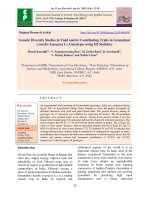
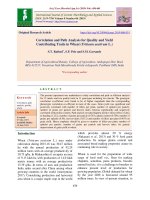
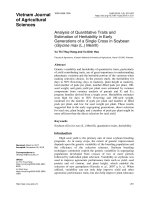


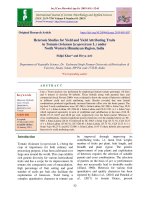
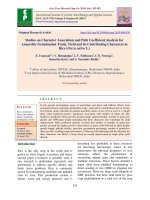
![Phenotypic and symbiotic diversity of Rhizobia isolated from root nodules of Soybean [Glycine max (L.) Merrill] in Côte D’ivoire](https://media.store123doc.com/images/document/2020_01/14/medium_ggg1578986959.jpg)